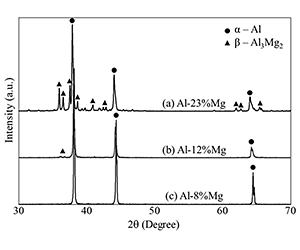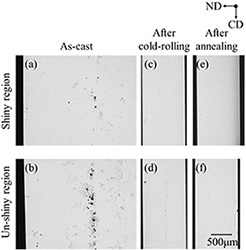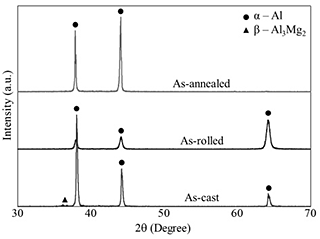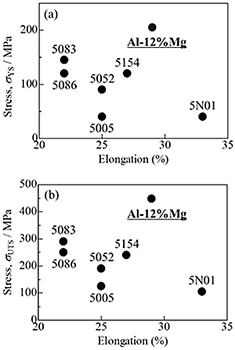Al-Mg alloy is a representative non-heat-treatable aluminum alloy. The main strengthening mechanism of the alloy is solid solution hardening by magnesium. If we can increase Mg solubility much more in the solid solutions by using the excellent cooling capacity of the vertical-type high-speed twin-roll casting, further improvement of strength is expected. In this study, high Mg containing Al-8%Mg, 12%Mg and 23%Mg alloy strips were fabricated by using this method, and increase in Mg solid solubility and mechanical properties were investigated. In order to investigate the maximum solid solubility of Mg by rapid solidification of vertical-type high-speed twin-roll casting, Al-23%Mg alloy strip was tried to cast. As a result, the strip was obtained even for such a high Mg content alloy. The XRD profile of the strip surface is shown in Fig. 1(a). In addition to the α-Al parent phase, many peaks of the β-Al3Mg2 phase were observed. Since the β phase is a brittle intermetallic compound, mechanical properties of the strip are deteriorated. Therefore, it is necessary to investigate the composition limit that the alloy does not crystallize the β phase under the cooling rate of the vertical-type high-speed twin-roll casting. Here, in order to estimate the Mg solid solubility, a linear relationship between the Mg solid solubility in the Al-Mg alloy and the lattice constant of the α-Al parent phase was used. The lattice constant was obtained from the peak position of the α-Al parent phase in the XRD profile shown in Fig. 1(a), and the estimated Mg solid solubility was about 12.0 %. Figures 1(b) and (c) show the XRD profiles of Al-12%Mg and Al-8%Mg alloy strip surfaces. Although the peaks of β phase were observed in the Al-12%Mg alloy strip, the peak strength was very small, and the estimated Mg solid solubility was about 10.4 %. No peak of β phase was observed in the Al-8%Mg alloy strip. The estimated Mg solid solubility was about 7.9 %, indicating that all the contained Mg was completely solid-solved. On the surface of the Al-Mg alloy strips fabricated by the vertical-type high-speed twin-roll casting, periodic patterns were observed in the casting direction consisting of the shiny region and un-shiny region with cracks. Figure 2 shows the cross-sectional images of the as-cast material, as-rolled material, and as-annealed material of Al-12%Mg alloy strips just below the shiny region and un-shiny region. Although porosities were observed in the central part of the plate thickness in both the shiny region and the un-shiny region of the as-cast material ((a), (b)), such slight porosities were almost eliminated after cold rolling ((c)-(f)). The XRD profiles of the Al-12%Mg alloy strip surface (as-cast, as-rolled, as-annealed) are shown in Fig. 3. The peaks of the β phase found in the as-cast material were not observed in the as-rolled and the as-annealed material. The peaks of the α-Al parent phase in the as-rolled and the as-annealed material were shifted to the lower angle, and the estimated Mg solid solubility was about 12.0 %. It is considered that the β phase slightly crystallized in the as-cast material was completely solid-solved into the parent phase by homogenization heat treatment (440°C - 6 h) and subsequent water cooling. Average values of the yield strength, the ultimate tensile strength, and the elongation of cold-rolled and annealed Al-12%Mg alloy sheet were 205±1.6 MPa, 448±2.7 MPa, 29.0±4.6 %, respectively. Figure 4 shows the yield strength, the ultimate tensile strength, and elongation of the several commercial Al-Mg alloy (for wrought, O tempered). The Al-12%Mg alloy sheet fabricated in this study has an excellent strength and ductility balance.
Mechanical Properties of Cold-Rolled and Annealed Al-12%Mg Alloy Sheet with
High Mg Solid Solubility Fabricated from Vertical-Type High-Speed Twin-Roll Cast Strip
[Published in Materials Transactions, Vol. 60, No. 11 (2019) pp. 2435-2441]

Fig. 1 XRD profiles of (a) Al-23%Mg, (b) Al-12%Mg, and (c) Al-8%Mg alloy strip surface (as-cast).

Fig. 2 Cross-sectional images of Al-12%Mg alloy strips. (a), (b) as-cast, (c), (d) as-rolled, (e), (f) as-annealed.

Fig. 3 XRD profiles of Al-12%Mg alloy strip surface (as-cast, as-rolled, as-annealed).

Fig. 4 Relationships between (a) yield strength and elongation, and (b) ultimate tensile strength and elongation of typical commercial Al-Mg alloy (for wrought, O tempered).